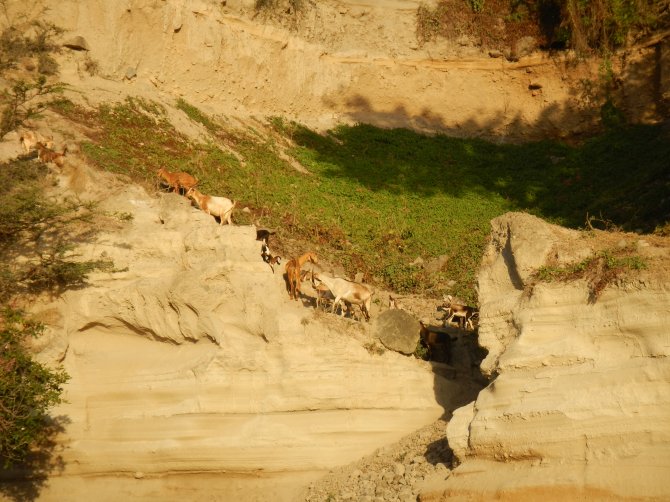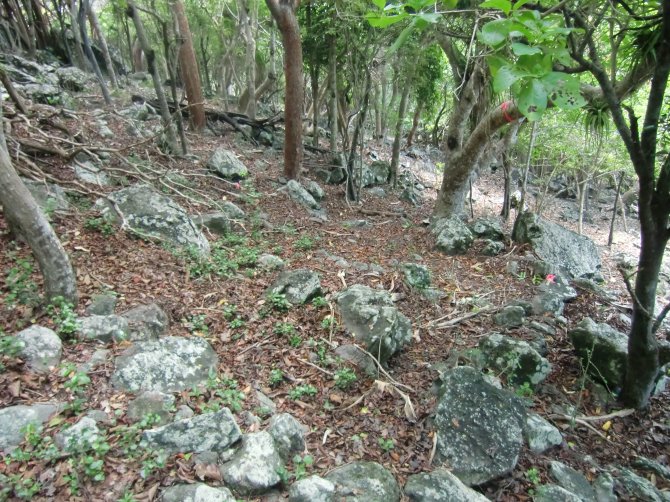
Project
Harmful invasive alien species (IAS) in the Caribbean Netherlands
Following climate change, IAS are recognised as the second-most serious long-term threat to island ecology, worldwide. Of all IAS issues, by far the most serious is the problem of roaming livestock. On most islands this concerns the eubiquitous domestic goat.
In addition to major inventories of invasive species (see the first 4 reports below) and the development of a joint strategy, as part of the Wageningen BO research program, IMARES has also led the way to several pilot-scale interventions, in close cooperation with island partners. Current studies include work to document the positive effect of feral cat control on survival of endangered ground-nesting seabirds in Saba, control and eradication of the Giant African Landsnail on Statia and control of goat grazing inside the Washington Slagbaai park in Bonaire. Within the European Netherlands, IAS are also recognized as a key scourge to both nature and economy and in 2015 stringent new legislation was implemented not only in the Netherlands, but throughout the EU. See below, for a full listing of IMARES recent work in this area of concern.
The problem of roaming livestock is particularly acute in the Caribbean Netherlands. It is a major impediment to agricultural development and nature conservation on St. Eustatius, as it also typically is on other islands in the region. In support of a government-led culling program, we here conducted a baseline study of livestock abundance and distribution on the island in the final quarter of 2013. In doing so we provide the first quantitative assessment of livestock densities ever in the Dutch Caribbean.

Population density of cattle, goats, sheep and chickens were estimated along 33.5 km of permanent trails, representing six different habitat zones using the Distance method. Each of the 13 trails was assessed five times. The results show overall high densities of chickens, goats and cattle. Clear and statistically significant livestock density differences were found in different zones of the island. The two most ubiquitous species of feral farm animals were goats and chickens, which were found in all habitat zones.

The density of roaming small ruminants (particularly goats) are currently at levels considered excessive for sustainable range management in other semi-arid landscapes. Our estimate for goat density per km2 and combined population size for the wooded habitats of the Northern Hills and the Quill where the terrestrial national parks are established was d = 109 ± 27 /km2.
Such livestock densities cause soil degradation, loss of organic matter, reduced water retention and erosion in semi-arid rangelands. Therefore, the results stress the need to cull, restrict and better manage the roaming livestock herds of the island. Of these, goats are the most problematic due to their habit of preferring steep terrain and cliffs. These are more vulnerable to erosion and harbour higher densities of rare species due to micro-habitat availability.
IAS Reports IMARES
-
Preliminary overview of exotic and invasive marine species in the Dutch Caribbean
Texel: IMARES (Report / IMARES Wageningen UR C188/11) -
Introduced agricultural pests, plant and animals diseases and vectors in the Dutch Caribbean, with an alert species list
Den Helder: IMARES (Report / IMARES Wageningen UR C193/11) -
Exotic and invasive terrestrial and freshwater animal species in the Dutch Caribbean
Texel: IMARES (Report / IMARES Wageningen UR C001/12) -
Naturalised and invasive alien plant species in the Caribbean Netherlands: status, distribution, threats, priorities and recommendations : report of a joint Imares/Carmabi/PRI project financed by the Dutch Ministry of Economic Affairs, Agriculture & Innovation
Wageningen: Plant Research International (Report / IMARES Wageningen UR C185/11) -
Key elements towards a Joint Invasive Alien Species Strategy for the Dutch Caribbean
Den Helder, Wageningen: IMARES (Report / IMARES Wageningen UR C020/14) -
Predation threats to the Red-billed Tropicbird breeding colony of Saba: focus on cats
Den Helder: IMARES (Report / IMARES Wageningen UR C011/14) -
Proximate response of fish, conch, and sea turtles to the presence of the invasive seagrass Halophila stipulacea in Bonaire
Den Helder: IMARES (Report / IMARES Wageningen UR C118/14) -
Roaming livestock distribution, densities and population estimates for St. Eustatius, 2013
Den Helder: IMARES (Report / IMARES Wageningen UR C088/15) -
Monitoring the effect of cat removal on reproductive success in Red-billed Tropicbird colonies on Saba, 2013 - 2014: first season of results
Den Helder: IMARES (Report / IMARES C103/15)
IAS publications IMARES
-
First record of a Caribbean green turtle (Chelonia mydas) grazing on invasive seagrass (Halophila stipulacea)
Caribbean Journal of Science (2014), Volume: 48, Issue: 2-3 - ISSN 0008-6452 - p. 162-163. -
Continued expansion of the trans-Atlantic invasive marine angiosperm Halophila stipulacea in the Eastern Caribbean
Aquatic Botany (2014), Volume: 112 - ISSN 0304-3770 - p. 98-102. -
Occurrence of the alien seagrass Halophila stipulacea in Martinique (French West Indies)
Marine Biodiversity Records (2013), Volume: 6 - ISSN 1755-2672
Continued expansion of the trans-Atlantic invasive marine angiosperm Halophila stipulacea in the Eastern Caribbean
Demian A. Willette, Julien Chalifour, A.O. Dolfi Debrot, M. Sabine Engel, Jeff Miller, Hazel A. Oxenford, Frederick T. Short, Sascha C.C. Steiner, Fabien Védie (2014) Aquatic Botany 112 (2014). - ISSN 0304-3770 - p. 98-102.